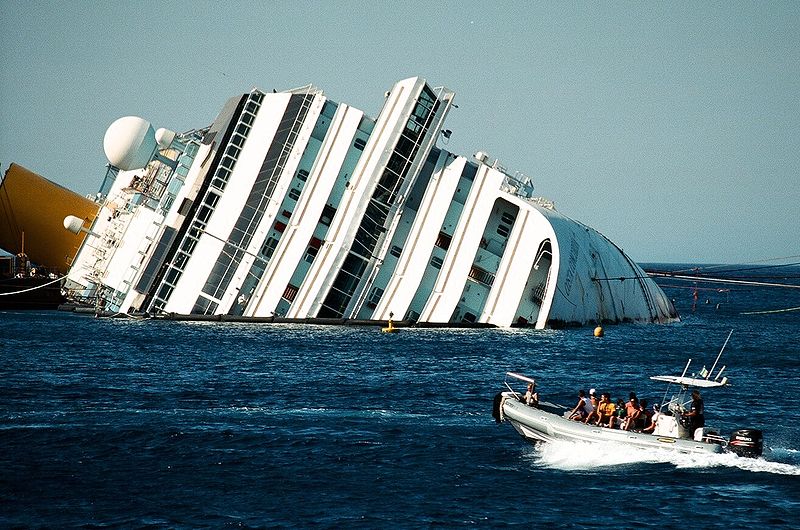Bad Luck Doesn’t Just Happen: The Case of the Costa Concordia
This is one of our free-to-access content pieces. To gain access to all Ideas for Leaders content please Log In Here or if you are not already a Subscriber then Subscribe Here.

Using the case of the Costa Concordia cruise ship sinking, researchers demonstrate the threat posed by ‘zemblanity.’ While serendipity occurs when a company is prepared to take advantage of good fortune, zemblanity is the polar opposite, occuring when a company creates its own bad luck.
Despite its best intentions, a company may have structures and processes in place that allows it to construct its own misfortune. This is organizational ‘zemblanity’, a term coined by writer William Boyd.
Zemblanity is the antonym of serendipity, which, in an organizational context, occurs when an organization purposefully puts itself in position to take advantage of lucky events.
It’s important to emphasize that zemblanity does not refer to negative events that might occur because of technical problems or even human error. Zemblanity is the result of a combination of ill-advised actions and decisions on the one hand and, on the other hand, structural deficiencies that fail to prevent those actions from leading the organization into a downwards spiral toward disaster.
The unfortunate events that led to the sinking of the Costa Concordia cruise ship provide a case study in zemblanity.
The giant cruise ship, with 4,000 people on board, struck some rocks near an island off the west coast of Italy. The captain had deliberately taken the ship off course and near those rocks in order to ‘salute’ the Isola del Giglio (saluting is the unsanctioned habit of sailing very close to land to give the people on land the experience of watching an enormous ship sail by almost within arm’s reach).
According to accident investigators, the captain, to avoid being tracked as he made the unsanctioned course change, took manual control of the ship. In addition, because he knew he was sailing so close to land that a collision warning signal would sound, investigators allege that he disconnected the warning mechanism.
The captain was confident he could sail the giant ship close to land without a problem, but he was wrong: the ship struck coastal rocks. When a collision occurs, international maritime rules calls for an immediate order to abandon ship, which must be evacuated within 60 minutes.
Instead, the captain would wait more than an hour after the accident, although there was no electricity on board and the ship was listing, before issuing the order to abandon ship. During that time, he announced to passengers that the loss of electricity was the result of a blackout that would be resolved; he also instructed his safety officer to lie to the coast guard (warned by a passenger) and inform them that the ship was not in trouble.
When after an hour the evacuation order was finally given (although passengers had started disembarking on their own), it would take six hours for the ship to be cleared — and 32 people would lose their lives. The captain was not one of those people, as he and the crew had disembarked before the ship was empty of passengers.
Breaking down the events, the researchers show that the tragedy occurred because human factors were allowed to overtake organizational controls.
The human factors were led by a captain who, incapable of experiencing doubt, gave himself excessive discretion — he engaged the ship in unsafe manoeuvres, ignored maritime safety protocol, and risked lives through his post-accident lies.
The captain’s disastrous decisions were, unfortunately, not countermanded by organizational controls, which lacked tackling mechanisms. For example, the crew had the right to refuse the captain’s orders, but they were so fully vested in the command-and-control hierarchy that they continued to obey orders. The head of the company’s crisis team, which was in contact with the captain during the event, urged the captain to issue the abandon ship order, but took no further steps. And if, as alleged, the safety technology had been disconnected, there was no remote override possible.
One of the major mistakes of the Costa Concordia’s owners was the assumption that a well-trained and experienced captain would make the best decisions in all circumstances.
The second mistake was to assume that the industry’s high level of formalization — including exhaustive rules for operating at sea, emergency procedures, technical instruments designed for emergencies, and a clear command-and-control leadership structure — would counter any human failings. Formalization, in fact, contributed to the disaster (as in the crew’s obedience); conflicting hierarchies — the company’s crisis team offsite, and the coast guard battling a captain who refuses to listen — further hampered the response.
Thus, the core lessons of the disaster for executives and companies are: do not assume in the due diligence of any human (in this case, both the captain and the first line of command were at fault), and do not assume that formal routines and structures (e.g., emergency procedures) will counteract human failings.
The principle of zemblanity is that bad luck does not just happen. In the Costa Concordia case, the core of the events begins with the captain ordering the ‘salute’ and ends with his leaving the sinking ship with endangered passengers still on board. In only 185 minutes, the captain tragically demonstrated the existence of organizational zemblanity.

Ideas for Leaders is a free-to-access site. If you enjoy our content and find it valuable, please consider subscribing to our Developing Leaders Quarterly publication, this presents academic, business and consultant perspectives on leadership issues in a beautifully produced, small volume delivered to your desk four times a year.

For the less than the price of a coffee a week you can read over 650 summaries of research that cost universities over $1 billion to produce.
Use our Ideas to:
Speak to us on how else you can leverage this content to benefit your organization. info@ideasforleaders.com